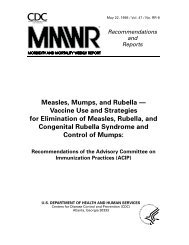Surveillance Manual - Chapter 21: Surveillance ... - The INCLEN Trust
Surveillance Manual - Chapter 21: Surveillance ... - The INCLEN Trust
Surveillance Manual - Chapter 21: Surveillance ... - The INCLEN Trust
Create successful ePaper yourself
Turn your PDF publications into a flip-book with our unique Google optimized e-Paper software.
<strong>21</strong><br />
VPD <strong>Surveillance</strong> <strong>Manual</strong>, 4th Edition, 2008<br />
<strong>Surveillance</strong> for Adverse Events Following Immunization: <strong>Chapter</strong> <strong>21</strong>-2<br />
II. Background<br />
Vaccines, like other pharmaceutical products, undergo extensive testing and review for safety,<br />
immunogenicity, and efficacy in trials with animals and humans before they are licensed.<br />
Because these trials usually include a placebo control or comparison group, it is possible to<br />
ascertain which local or systemic reactions were actually caused by the vaccine. However,<br />
prelicensure trials are relatively small—usually limited to a few thousand subjects—and<br />
usually last no longer than a few years. In addition, they may be conducted in populations less<br />
demographically, racially, and ethnically diverse than those in which the vaccine is ultimately<br />
used. During prelicensure testing, detection of uncommon adverse events with delayed onset is<br />
not highly sensitive. Postlicensure or postmarketing surveillance—the continuous monitoring of<br />
vaccine safety in the general population after licensure—is needed to identify and evaluate such<br />
adverse events. 9<br />
<strong>The</strong> history of postmarketing surveillance for vaccine adverse events in the United States has<br />
been reviewed elsewhere. 10 From 1978 through 1990, the Centers for Disease Control (CDC)<br />
and the Food and Drug Administration (FDA) divided the responsibility for postmarketing<br />
surveillance of vaccines in the United States. Reports of adverse events following<br />
administration of vaccines purchased with public funds were submitted to CDC’s Monitoring<br />
System for Adverse Events Following Immunization (MSAEFI); the FDA received reports<br />
of adverse events after administration of vaccine purchased with private funds. Although<br />
collaboration was maintained between the two agencies, the use of different reporting forms and<br />
reporting requirements made combined analysis difficult.<br />
<strong>The</strong> passage of the National Childhood Vaccine Injury Act of 1986 (NCVIA) and its mandatory<br />
reporting requirement was an opportunity to correct these shortcomings. With enactment of<br />
the NCVIA, vaccine manufacturers licensed in the United States and healthcare providers who<br />
administer vaccines are required by law to report certain serious adverse events following<br />
specific vaccinations. 11 <strong>The</strong> NCVIA’s purposes were to compensate persons who may have been<br />
injured by vaccines and to reduce threats to the stability of the immunization program (liability<br />
concerns, inadequate supply of vaccine, rising vaccine costs). 12 <strong>The</strong> NCVIA stipulates the<br />
vaccines, the adverse events, and the time of occurrence after vaccination for which reporting<br />
is required (Table 2). It also requires that any event listed in the manufacturer’s package insert<br />
as a contraindication to subsequent doses of the vaccine be reported. In 1990, the Department<br />
of Health and Human Services (DHHS) directed that a single system be established for the<br />
collection and analysis of reports of adverse events following immunization. 13 This led to the<br />
establishment of the Vaccine Adverse Event Reporting System (VAERS), which is cosponsored<br />
by CDC and FDA. Programs such as VAERS exist in many countries; some monitor vaccines<br />
separately from other drug products, but many are joint programs. <strong>The</strong>se programs form the<br />
cornerstone of drug safety monitoring efforts around the world.<br />
Table 2. VAERS Table of Reportable Events Following Vaccination*<br />
Vaccine/Toxoid<br />
Tetanus in any<br />
combination; DTaP,<br />
DTP, DTP-Hib, DT, Td,<br />
TT, Tdap<br />
Pertussis in any<br />
combination; DTaP,<br />
DTP, DTP-Hib, Tdap<br />
Event<br />
Anaphylaxis or anaphylactic shock<br />
Brachial neuritis<br />
Any acute complications or sequelae (including death)<br />
of above events<br />
Events described in manufacturer’s package insert as<br />
contraindications to additional doses of vaccine<br />
Anaphylaxis or anaphylactic shock<br />
Encephalopathy (or encephalitis)<br />
Any acute complications or sequelae (including death)<br />
of above events<br />
Events described in manufacturer’s package insert as<br />
contraindications to additional doses of vaccine<br />
7 days<br />
Interval from<br />
Vaccination<br />
28 days<br />
Not applicable<br />
See package insert<br />
7 days<br />
7 days<br />
Not applicable<br />
See package insert

















